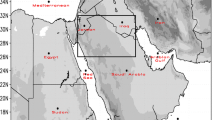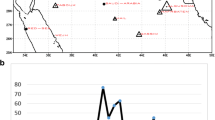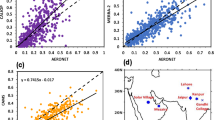Abstract
The relationship between local meteorological fields and the behaviour of airborne Asian dust that arrived in the Tokyo metropolitan area on 1 April 2007 with the passage of a synoptic-scale cold front has been investigated through Doppler lidar observations, experiments using a regional atmospheric numerical model, and analyses of surface and upper-air meteorological observations. Results of the Doppler lidar observations showed that the Asian dust passed above the metropolitan area with strong south-westerly winds with speeds of 15–26 m s−1. Meteorological fields reproduced by the numerical experiments showed the development of a surface-based stable layer in the metropolitan area caused by nocturnal radiational cooling near the ground surface and south-westerly warm air advection at upper levels. The blocking effect of the mountainous region located to the west of the metropolitan area induced an area of stagnant air inside the metropolitan area and promoted the stable layer development. Although strong downdrafts prevailed in the upper air, the airborne Asian dust did not spread to the ground when the stable layer was formed. These results strongly indicate that the developed stable layer prevented strong downdrafts from spreading to the ground, acting as an obstacle to the transport of the Asian dust particles from the upper air towards the ground. This is considered to be one of the main causes of the low appearance frequency of Asian dust phenomena near the ground in the Tokyo metropolitan area and eastern Japan.
Similar content being viewed by others
References
Aoki I, Kurosaki Y, Osada R, Sato T, Kimura F (2005) Dust storms generated by mesoscale cold fronts in the Tarim Basin, Northwest China. Geophys Res Lett 32: L06807. doi:10.1029/2004GL021776
Arakawa A, Schubert WH (1974) Interaction of a cumulus cloud ensemble with the large-scale environment, Part I. J Atmos Sci 31: 674–701. doi:10.1175/1520-0469(1974)031<0674:IOACCE>2.0.CO;2
Darby LS, Banta RM, Pielke RA (2002) Comparisons between mesoscale model terrain sensitivity studies and Doppler lidar measurements of the sea breeze at Monterey bay. Mon Weather Rev 130: 2813–2838. doi:10.1175/1520-0493(2002)130<2813:CBMMTS>2.0.CO;2
Ishii S, Sasaki K, Mizutani K, Aoki T, Itabe T, Kanno H, Matsushima D, Sha W, Noda AT, Sawada M, Ujiie M, Matsuura Y, Iwasaki T (2007) Temporal evolution and spatial structure of the local easterly wind “Kiyokawa-Dashi” in Japan PART I: coherent Doppler lidar observations. J Meteorol Soc Jpn 85: 797–813. doi:10.2151/jmsj.85.797
Kai K, Okada Y, Uchino O, Tabata I, Nakamura H, Takasugi Y, Nikaidou Y (1988) Lidar observation and numerical simulation of a Kosa (Asian Dust) over Tsukuba, Japan during the spring of 1986. J Meteorol Soc Jpn 66: 457–472
Kalnay E, Kanamitsu M, Kistler R, Collins W, Deaven D, Gandin L, Iredell M, Saha S, White G, Woollen J, Zhu Y, Leetmaa A, Reynolds B, Chelliah M, Ebisuzaki W, Higgins W, Janowiak J, Mo KC, Ropelewski C, Wang J, Jenne R, Joseph D (1996) The NCEP/NCAR 40-year reanalysis project. Bull Am Meteorol Soc 77: 437–472. doi:10.1175/1520-0477(1996)077<0437:TNYRP>2.0.CO;2
Kurosaki Y, Mikami M (2005) Regional difference in the characteristic of dust event in East Asia: relationship among dust outbreak, surface wind, and land surface condition. J Meteorol Soc Jpn 83A: 1–18. doi:10.2151/jmsj.83A.1
Liu Z, Sugimoto N, Murayama T (2002) Extinction-to-backscatter ratio of Asian dust observed with high-spectral-resolution lidar and Raman lidar. Appl Opt 41: 2760–2767. doi:10.1364/AO.41.002760
Louis J-F (1979) A parametric model of vertical eddy fluxes in the atmosphere. Boundary-Layer Meteorol 17: 187–202. doi:10.1007/BF00117978
Ministry of the Environment Government of Japan (2005) Abstract of the Special Committee Report on Dust and Sandstorm Issues, 6 pp. http://www.env.go.jp/en/earth/dss/
Murayama T, Sugimoto N, Matsui I, Arao K, Iokibe K, Koga R, Sakai T, Kubota Y, Saito Y, Abo M, Hagiwara N, Kuze H, Kaneyasu N, Imasu R, Asai K, Aoki K (1998) Lidar network observation of Asian dust (Kosa) in Japan. SPIE 3504: 8–15. doi:10.1117/12.319584
Mellor GL, Yamada T (1982) Development of a turbulence closure model for geophysical fluid problems. Rev Geophys Space Phys 20: 851–875. doi:10.1029/RG020i004p00851
Nakajima T, Tsukamoto M, Tsushima Y, Numaguti A, Kimura T (2000) Modeling of the radiative process in an atmospheric general circulation model. Appl Opt 39: 4869–4878. doi:10.1364/AO.39.004869
Pielke RA, Cotton WR, Walko RL, Tremback CJ, Lyons WA, Grasso LD, Nicholls ME, Moran MD, Wesley DA, Lee TJ, Copeland JH (1992) A comprehensive meteorological modeling system RAMS. Meteorol Atmos Phys 49: 69–91. doi:10.1007/BF01025401
Sakai T, Nagai T, Nakazato M, Mano Y, Matsumura T (2003) Ice clouds and Asian dust studied with lidar measurements of particle extinction-to-backscatter ratio, particle depolarization, and water-vapor mixing ratio over Tsukuba. Appl Opt 42: 7103–7116. doi:10.1364/AO.42.007103
Sato T, Kimura F (2005) Diurnal cycle of convective instability around the Central Mountains in Japan during the warm season. J Atmos Sci 62: 1626–1636. doi:10.1175/JAS3423.1
Yoshikado H, Yoshikado H, Yoshikado H, Kobayashi F, Sato J, MembersofTsukubaArea Precipitation Studies (2003) Vertical structure of local fronts observed in Kanto, Japan. J Meteorol Soc Jpn 81: 367–391. doi:10.2151/jmsj.81.367
Shao Y, Jung E, Leslie LM (2002) Numerical prediction of northeast Asian dust storms using an integrated wind erosion modeling system. J Geophys Res 107(D24): 4814. doi:10.1029/2001JD001493
Takemi T (1999) Structure and evolution of a severe squall line over the arid region in northwest China. Mon Weather Rev 127: 1301–1309. doi:10.1175/1520-0493(1999)127<1301:SAEOAS>2.0.CO;2
Tsunematsu N (2005) Observed dust storm in the Taklimakan Desert on April 13, 2002. Sci Online Lett Atmos, SOLA 1: 21–24
Tsunematsu N, Kai K (2004) Time variation of cloud distribution near surface wind convergence zone in the Nobi Plain during daytime on summer sunny days. J Meteorol Soc Jpn 82: 1505–1520. doi:10.2151/jmsj.82.1505
Tsunematsu N, Sato T, Kimura F, Kai K, Kurosaki Y, Nagai T, Zhou H, Mikami M (2005) Extensive dust outbreaks following the morning inversion breakup in the Taklimakan Desert. J Geophys Res 110: D21207. doi:10.1029/2005JD005994
Tsunematsu N, Sakai T, Nagai T (2006) Strong capping inversion over the Tokyo metropolitan area associated with airborne Asian dust. Geophys Res Lett 33: L19806. doi:10.1029/2006GL026645
Tsunematsu N, Nagai T, Murayama T, Adachi A, Murayama Y (2008) Volcanic ash transport from Mount Asama to the Tokyo metropolitan area influenced by large-scale local wind circulation. J Appl Meteorol Climatol 47: 1248–1265. doi:10.1175/2007JAMC1644.1
Turner R, Hurst T (2001) Factors influencing volcanic ash dispersal from the 1995 and 1996 eruptions of Mount Ruapehu, New Zealand. J Appl Meteorol 40: 56–69. doi:10.1175/1520-0450(2001)040<0056:FIVADF>2.0.CO;2
Walko RL, Cotton WR, Meyers MP, Harrington JY (1995) New RAMS cloud microphysics parameterization, Part I: the single-moment scheme. Atmos Res 38: 29–62. doi:10.1016/0169-8095(94)00087-T
Yoshikado H, Mizuno T, Shimogata S (1994) Terrain-induced air stagnation over the southern Kanto Plain in early winter. Boundary-Layer Meteorol 68: 159–172. doi:10.1007/BF00712669
Yoshikane T, Kimura F, Emori S (2001) Numerical study on the Baiu Front genesis by heating contrast between land and ocean. J Meteorol Soc Jpn 79: 671–686. doi:10.2151/jmsj.79.671
Author information
Authors and Affiliations
Corresponding author
Rights and permissions
About this article
Cite this article
Tsunematsu, N., Iwai, H., Ishii, S. et al. Influence of Surface-Based Stable Layer Development on Asian Dust Behaviour Over Tokyo. Boundary-Layer Meteorol 131, 263–275 (2009). https://doi.org/10.1007/s10546-009-9366-6
Received:
Accepted:
Published:
Issue Date:
DOI: https://doi.org/10.1007/s10546-009-9366-6




